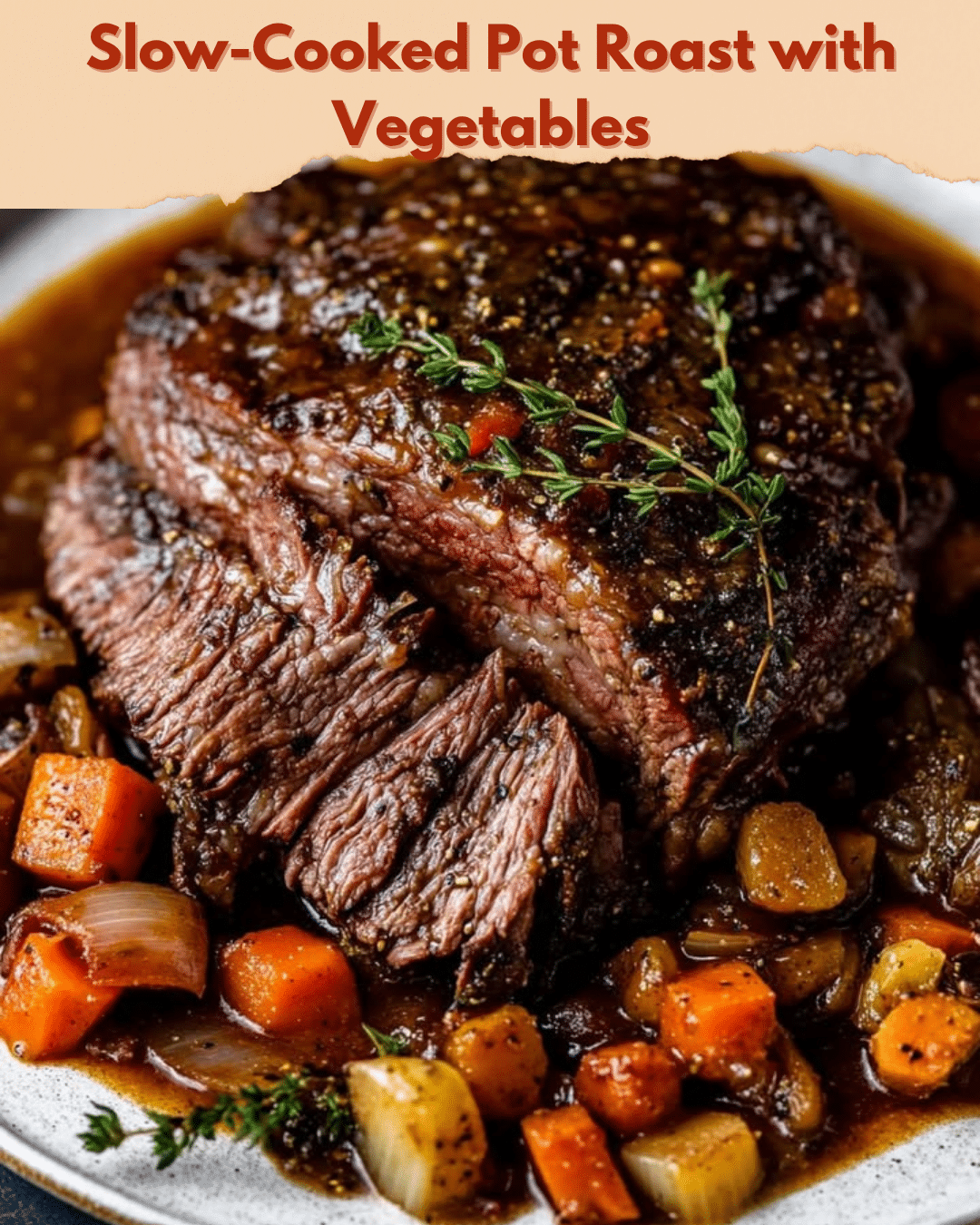Delicious Slow-Cooked Pot Roast with Vegetables: A Comforting Classic
The Slow-Cooked Pot Roast with Vegetables is the ultimate comfort dish, perfect for a cozy family dinner. This hearty recipe combines tender beef with a medley of aromatic vegetables, creating a flavorsome meal that’s sure to satisfy. The slow cooking process ensures the meat melts in your mouth, while the vegetables soak up the delicious juices, resulting in a dish that’s both savory and nutritious. Whether it’s a chilly winter evening or you’re hosting a weekend gathering, this classic pot roast will bring warmth and togetherness to your table.
This dish embodies everything that’s wonderful about home-cooked meals. The aromas that fill the kitchen as it simmers away are simply irresistible. Imagine the robust scent of beef melding seamlessly with herbs, onions, and garlic, complemented by a subtle sweetness from carrots and potatoes. Each bite is a symphony of flavors, with the beef’s rich umami notes balanced by the freshness of the vegetables. It’s a dish steeped in tradition yet incredibly versatile, easily adapting to various preferences and seasonal ingredients.
Quick Recipe Highlights
– Flavor Profile: The slow-cooked pot roast boasts a rich and savory flavor thanks to the beef’s umami richness, complemented by aromatic vegetables that bring subtle sweetness and earthiness.
– Texture: The pot roast delivers a tender, melt-in-your-mouth texture, where the beef shreds easily, and the vegetables are perfectly soft yet firm enough to maintain their shape.
– Aroma: As the pot roast cooks, it fills your kitchen with an intoxicating aroma of simmering beef, fragrant herbs, and sweet vegetables, promising a comforting meal ahead.
– Visual Appeal: Visually, the pot roast is a feast for the eyes, with deep brown beef and a colorful array of vegetables, making it as inviting as it is delicious.
– Skill Level Needed: This recipe is perfect for intermediate cooks. Although simple, it requires patience and attention to achieve the perfect texture and flavor.
– Special Equipment: A slow cooker or a Dutch oven is essential for this recipe, facilitating even cooking and flavor development over several hours.
Recipe Overview
– Difficulty Level: This pot roast is moderately complex, requiring some preparation and technique to ensure the beef’s desired tenderness. Slow cooking aids in developing deep flavors.
– Category: This meal falls under main courses, ideal for dinner and suitable for both family meals and gatherings.
– Cuisine: The pot roast is a classic dish within American cuisine, influenced by European cooking traditions, particularly braising methods.
– Cost: Depending on beef cut selection, the dish is relatively affordable, with vegetables and base seasonings keeping costs manageable.
– Season: Best prepared during cooler months when hearty and warming dishes are most appreciated, though variations can be enjoyed year-round.
– Occasion: This recipe is perfect for occasions like Sunday family dinners or casual gatherings, providing a sense of warmth and hospitality.
Why You’ll Love This Recipe
Taste and texture appeal are at the heart of this slow-cooked pot roast, offering a distinct depth of flavor that traditional cooking methods bring out. The slow cooking ensures the beef is tender, and the vegetables absorb flavorful juices, creating a delightful mouthfeel. Furthermore, the convenience of this recipe can’t be overlooked—after initial preparation, the slow cooker takes over, allowing you to focus on other tasks while dinner gently simmers away.
From a nutritional standpoint, this dish offers a well-rounded profile. The protein-rich beef and fiber-filled vegetables make it a balanced meal. Plus, the possibility of modifying the ingredients to suit dietary needs, such as reducing calories by using less oil, is an added benefit. In a social context, serving this pot roast can elevate a meal from simple to exceptional, making it a centerpiece for gatherings that spark conversation and shared enjoyment.
Cost-effectiveness is another selling point of this recipe. While it delivers a gourmet experience, the ingredients can be sourced economically, especially if using seasonal vegetables. Slow cooking also means you can utilize more affordable cuts of beef, as the process tenderizes the meat perfectly. Accessibility to the ingredients year-round ensures you can enjoy this comforting classic whenever a craving strikes.
Historical Background and Cultural Significance
The pot roast’s origin story is rooted in traditional European cooking methods, specifically braising, which involves slow cooking meat in liquid. This method was adopted in America in the 19th century, becoming a household staple due to its ability to tenderize tough cuts of meat, maximizing the use of available resources. Over time, it became synonymous with comfort food, offering warmth and nourishment.
Culturally, the pot roast holds significant importance in American culinary history, symbolizing home-cooked comfort and family gatherings. It’s a dish that has been passed down through generations, often served at family dinners and special occasions. As such, it represents both tradition and the evolution of home cooking in America.
The evolution of the pot roast has seen various adaptations and influences, with regional variations making use of local ingredients. For instance, the addition of Mexican spices provides a fiery twist, while using wine in the braising liquid adds a sophisticated depth borrowed from French cuisine. These variations highlight the dish’s flexibility and its ability to transcend culinary borders, adapting to diverse tastes and cultures.
Regionally, the pot roast varies in ingredient choice and cooking method. In the South, it might include sweet potatoes for a hint of sugary warmth, whereas Midwestern versions focus on root vegetables like parsnips and turnips. In New England, pot roasts are typically served with gravy made from pan drippings, reflecting the abundance of local produce and traditional meat-centric diets.
Ingredient Deep Dive
Beef is the star of this pot roast, celebrated for its hearty texture and deep flavor. Historically, beef has been a versatile staple in European and American diets, prized for its protein content and ability to feed many. When selecting beef for pot roast, aim for cuts such as chuck, brisket, or bottom round—these are ideal for slow cooking, becoming tender and flavorful over time. Be sure to store them in a cold environment to maintain freshness and consider freezing if not used immediately.
The vegetables—carrots, potatoes, and onions—add essential nutrients like beta-carotene, vitamins, and fiber. Carrots bring a subtle sweetness, while potatoes add heartiness, making them staples in traditional pot roasts. When shopping, select firm, blemish-free produce, storing them in a cool, dark place to retain their quality. If needed, vegetables can be substituted with other seasonal options like parsnips or sweet potatoes, allowing for flexibility in taste and nutritional content.
Common Mistakes to Avoid
1. Choosing the Wrong Cut of Beef: Opt for tougher cuts like chuck, which tenderize through slow cooking, rather than lean cuts that become dry.
2. Not Searing the Meat: Failing to sear the meat on all sides can result in less flavor; the caramelization process is crucial for depth.
3. Skipping the Deglazing Step: Always deglaze the pan with liquid to incorporate delicious caramelized bits into the braising liquid.
4. Overcrowding the Slow Cooker: Ensure space for circulation by not filling the cooker to the brim, which could impede even cooking.
5. Under-seasoning: A common mistake; season generously at each stage to enhance flavor throughout the dish.
6. Ignoring Cooking Times: Avoid shortening cooking time—pot roast requires thorough slow cooking to achieve the desired tenderness.
7. Cutting Vegetables Too Small: Keep vegetables chunk-sized to prevent them from disintegrating during the slow cooking process.
8. Adding Dairy Too Soon: If using creamy elements (like sour cream), add in the last 15 minutes to avoid curdling.
9. Lifting the Lid Frequently: Opening the slow cooker disrupts the temperature and extends cooking time—resist the urge to peek.
10. Disregarding Rest Time: Post-cooking, let the pot roast rest to allow juices to redistribute, enhancing flavor and moisture.
Essential Techniques
The art of searing is vital to enhancing the flavor of your pot roast. This technique involves browning the meat over high heat before slow cooking. The process creates a Maillard reaction, which caramelizes natural sugars and develops a rich, complex crust that flavors the entire dish. Mastering this technique requires patience and a hot pan, waiting until a golden-brown color appears before flipping the meat—avoid overcrowding to ensure even searing.
Equally important is the deglazing process. After searing, fond or flavorful bits remain in the pan. By adding liquid—like broth or wine—and scraping the bottom, these bits dissolve, enhancing flavor and integrating into the cooking liquid. Ensuring complete deglazing avoids wasted flavor and contributes significantly to the roast’s robustness.
Pro Tips for Perfect Slow-Cooked Pot Roast
1. Choose the Right Cut: For best results, use a marbled cut like chuck or brisket, perfect for slow cooking.
2. Prep Ahead: Chop vegetables a day before to save time and enhance flavor infusion.
3. Control the Liquid Level: Only add enough liquid to cover the meat halfway; too much liquid dilutes the flavors.
4. Adjust Seasoning: Tasting and adjusting seasoning throughout cooking ensures balanced flavors.
5. Cook Low and Slow: Patience is key; low heat yields tender meat and rich broth.
6. Use Aromatics Liberally: Incorporate garlic, bay leaves, and thyme for depth and complexity.
7. Keep an Eye on Liquid: Check periodically, adding more if it reduces too much.
8. Allow Resting Time: Proper resting post-cooking redistributes juices, enhancing overall taste.
Variations and Adaptations
Pot roast can vary widely across regions and seasons. For a Mediterranean flair, incorporate olives and sun-dried tomatoes. Similarly, adapting to seasonal ingredients can bring new dimensions—for example, including butternut squash in the fall adds warmth and sweetness. For dietary modifications, consider using a leaner cut for a low-fat option or going vegan by substituting beef with hearty mushrooms and vegetable stock.
To vary flavors, experiment with different seasoning combinations such as adding smoked paprika for spice or using rosemary for an earthy tone. Texture modifications can involve swapping potatoes for beans, providing creaminess and fiber. Presentation alternatives might include slicing the pot roast and serving it over polenta or mashed cauliflower for a refined look.
Serving and Presentation Guide
Elevate your pot roast with thoughtful plating techniques. Arrange beef slices in the center of the plate, surround with vegetables for color contrast, and drizzle the sauce artistically across the top. Garnishing with fresh parsley adds brightness and freshness, while traditional accompaniments like crusty bread or mashed potatoes complement its richness.
For modern serving suggestions, consider a deconstructed pot roast bowl, layering shredded beef and vegetables with grains like quinoa. Serve hot to maximize flavor, and control portions to ensure a balanced dish, both visually and nutritionally.
Wine and Beverage Pairing
Pairing pot roast with the right wine accentuates its flavors. Choose robust reds like Cabernet Sauvignon or Malbec, whose tannins complement the beef. For non-alcoholic options, a rich grape juice or a spiced apple cider pairs well, standing up to the roast’s bold flavors.
If opting for coffee or tea pairings, a dark roast coffee or smoky black tea can balance the richness. Aim to serve beverages at an appropriate temperature to match the roast—cool whites or warm reds enhance different aspects of the dish’s profile.
Storage and Shelf Life
Proper storage is crucial for maintaining the quality of your pot roast. After cooling, transfer leftovers to airtight containers and refrigerate them promptly. They will stay fresh for up to three days. Freeze if storing beyond this period, ensuring airtight sealing to prevent freezer burn. Signs of spoilage include off odors or mold—discard if these occur.
For reheating, use a low oven or stovetop to avoid texture change. Add liquid to prevent drying out, and avoid microwaves if possible, as they can toughen the meat. When freezing, consider portioning out individual servings for convenience.
Make Ahead Strategies
For a streamlined cooking process, prepare components in advance. Marinade the beef a day before for intensified flavor. Veggies can also be pre-chopped and stored separately, ensuring freshness. Slow-cook the dish a day ahead, then refrigerate—this can enhance flavor development.
Reheat and add fresh elements like herbs right before serving to maintain a vibrant taste. Assembly techniques, like plating with strategic placement of meat and veggies, ensure visual appeal upon serving.
Scaling Instructions
Scaling the pot roast recipe up or down can be done with ease. For smaller batches, halve the ingredients, maintaining ratios for a balanced flavor. Doubling is straightforward, though using larger equipment like a bigger slow cooker or Dutch oven is key.
Adjust timing for larger quantities, adding extra cooking time as needed. Ensure the storage capacity is available, considering refrigeration space for leftovers when scaling up.
Nutritional Deep Dive
The pot roast provides a balanced macro profile with ample protein and carbs from beef and vegetables. It’s rich in nutrients like iron from beef and vitamin A from carrots. Adjustments can be made for dietary concerns, such as reducing sodium.
For portion control, consider serving smaller meat portions with a higher vegetable ratio, maintaining balance while managing calorie intake. This dish offers both taste and nutritional benefits supporting a wholesome diet.
Dietary Adaptations
For gluten-free adaptations, ensure all broths and seasonings are certified gluten-free. Dairy-free modifications involve omitting or substituting creamy elements. For vegans, use mushrooms and vegetable broth as substitutes.
Low-carb and keto dieters can enjoy the dish by replacing high-carb vegetables with low-carb alternatives like cauliflower. Paleo dieters should choose clean, unprocessed meats and natural seasonings.
Troubleshooting Guide
Address common texture issues by ensuring proper cooking time—if the meat is tough, it needs more slow-cooking. Balance flavors by adjusting seasoning and broth reduction. Temperature problems are often resolved by checking slow cooker settings.
Equipment challenges, like a too-small cooker, can be mitigated by scaling the recipe or transferring to oven-safe dishes. Substitute carefully, ensuring replacements complement dish characteristics.
Recipe Success Stories
The pot roast has long been a favorite among our community. Readers appreciate its versatility, with suggestions like adding parsnips or stirring in a touch of mustard for flavor variance. Variations like a spicy kick with chili peppers or a savory twist with soy sauce have been shared with success.
Photography tips include focusing on beef slices with visible marbling and emphasizing colorful vegetable accents for visual appeal.
Frequently Asked Questions
2. How do I know when the pot roast is done? The meat should be tender, easily shreddable with a fork, indicating it’s properly cooked.
3. Are there vegetarian alternatives for this recipe? Yes, hearty mushrooms make a great meaty substitute for a completely plant-based version.
4. Can I use frozen beef for this recipe? It’s recommended to thaw beef completely before cooking to ensure even cooking and flavor absorption.
5. What wines pair best with pot roast? Rich reds like Cabernet Sauvignon are excellent choices, complementing the beef’s robustness.
6. How can I thicken the broth into gravy? Removing some broth and whisking it with flour before returning to the pot creates a thicker consistency.
7. Must I sear the meat first? While optional, searing enhances flavor significantly through Maillard browning.
8. Can this recipe fit different dietary needs? Adjusting vegetables or using alternative seasoning can help tailor this recipe to specific diets.
9. Should the pot roast be covered during cooking? Yes, covering ensures even heat distribution, leading to consistent texture.
10. Is it possible to add extra vegetables? Absolutely, additional vegetables like squash or zucchini can enhance the dish based on preference.
11. How do I store leftovers safely? Use airtight containers, refrigerating for up to 3 days or freezing for extended preservation.
12. Can I cook this overnight? Yes, setting the slow cooker to low heat allows for safe overnight cooking without concerns of overcooking.
Additional Resources
For those new to slow cooking, our slow cooker guide provides practical tips for maximizing this method’s benefits. Related recipes, like our braised short ribs or classic stew, offer similar rustic flavors and hearty comfort. For insights into selecting quality beef cuts, explore our beef guide, which also covers preparation and cooking techniques.
Seasonal variations, like summer slow cooker options, ensure you enjoy the pot roast experience year-round, adapting to your taste and ingredient availability. Explore these resources for more inspiration and mastery of slow-cooked meals.
Print
Slow-Cooked Pot Roast with Vegetables
Description
This slow-cooked pot roast with vegetables is tender, flavorful, and perfect for a hearty family meal.
Ingredients
For the Crust:
- 2 pounds beef chuck roast
- 4 large carrots, peeled and sliced
- 1 large onion, sliced
- 4 cloves garlic, minced
- 3 cups beef broth
- 2 tablespoons Worcestershire sauce
- 1 tablespoon olive oil
- Salt and pepper to taste
Instructions
1. Prepare the Crust:
- Season the beef chuck roast with salt and pepper.
- Heat olive oil in a pan over medium-high heat and brown the roast on all sides.
- Place the roast in a slow cooker and add carrots, onion, garlic, beef broth, and Worcestershire sauce.
- Cover and cook on low for 8-10 hours or until the meat is tender.
- Remove the roast and let it rest before slicing. Serve with vegetables and sauce.
Notes
You can customize the seasonings to taste.





